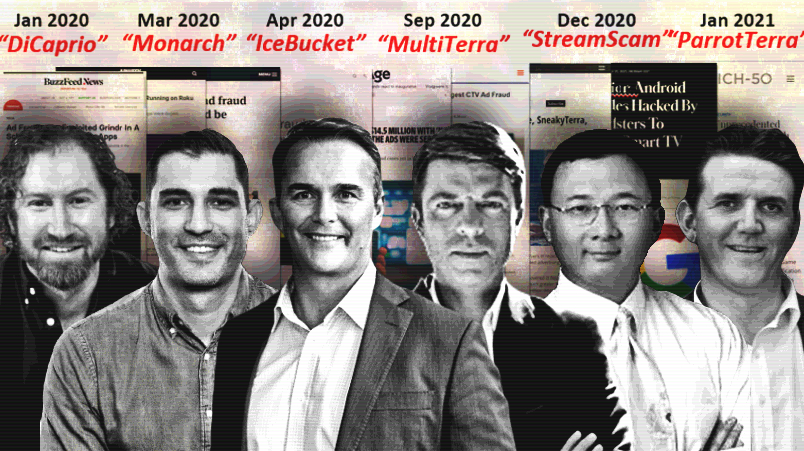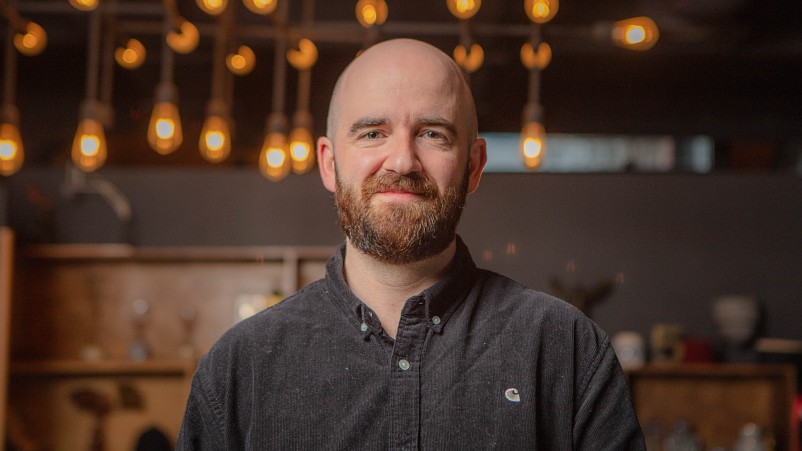Dark patterns: Connected TV viewing is booming – and so are advertising fraud syndicates. Here’s why Australia is avoiding the crims – for now.

Seven's Chief Revenue Officer, Kurt Burnette: "In the US they have more open market deals than we do, so that would certainly raise the occurrences of fraud."
Australia has dodged the Connected TV (CTV) ad fraud wave hitting the red hot global CTV markets - for now. Fraudsters have inevitably piled in with more than a dozen high-profile scams already yielding large elicit returns from open exchanges for criminal syndicates, dodgy operators and for the adtech ecosystem that services them - 17% of CTV ads don't reach real people according to GroupM and iSpot. But Australia so far is mostly immune - the lack of premium video and BVOD ad inventory released into the broader adtech system by broadcaster-controlled platforms might frustrate advertising intermediaries but its keeping the fraudsters at bay - but for how long?
What you need to know
- As spending in the CTV market surges, ad fraudsters are moving in, attracted by the high yields, and by the lax surveillance of tier 2 publishers and ad tech providers.
- Australia's current market structure - a small group of premium broadcasters offering almost exclusively direct deals, and working with a select group of SSPs and agencies is mitigating against the kinds of fraud levels seen overseas.
- But that could change if CTV demand scales quickly here, creating pressure to hive more inventory off to open exchanges, or if a tightly-controlled local market tempts lower cost publishing entrants to try their hand.
- See the summary below for the top ad fraud schemes that have hit CTV ad markets.
It's not the big TV networks committing the fraud. It's bad guys pretending to have inventory from big TV networks and selling it on exchanges. If you buy CTV ads from exchanges then they can't tell apart the ad impressions where bad guys pretend to be big TV networks.
Broadcasters contain the crims
Market scale is often seen as a limiting factor for innovation across many Australian industries, but for now it may be helping to buttress the rapidly growing local CTV scene from the kinds of fraudulent activity that have characterised the rise of the sector in the US.
CTV is grabbing an increasing share of ad dollars from brands as viewers stick with big TV screens but opt for IP-delivered content over roof top aerials. But that extra loot is also attracting ad fraudsters who are as attracted to the high-yielding inventory as they are to the lackadaisical surveillance of some in the ad tech ecosystem, along with brands and agencies who buy their services.
Pixalate estimates that in 2022 advertisers in the US would lose over $135 million in the CTV open programmatic marketplace just from spoofed Roku and Amazon Fire TV apps.
Ad spending worldwide in the sector is expected to grow from $US26.21bn in 2022 to $48.63bn in 2027 according to business statistics site Statista.
Our total [advertising] exchange revenue would be under one per cent - at the most it's always under 2 per cent. The fluctuation is very small. There is zero intention for that to change in the next 36 months
Attack vectors
Locally, CTV now accounts for 36 percent of the $1.6bn generated from online video, according to IAB Australia.
And just as surely as ad dollars follow eyeballs, ad fraudsters will chase new revenue opportunities, and CTV with its high inventory prices and relative market immaturity.
But key players in Australia’s CTV ecosystem believe market structure will spare advertisers the kinds of losses revealed across a series of high-profile ad frauds in recent years.
They say the local sector is currently dominated by few smaller, premium national broadcasters channeling over 95 per cent [98-99 per cent in the case of Nine and Seven] of their inventory into private deals managed by a small and select group of SSPs. A limited set of agencies with specialist capabilities helping to facilitate the deals likewise limits the risk, they believe.
Contrast that with the US, where market scale means many more operators, including smaller regional TV players working with a much wider set of adtech supply chain partners, creates a wider set of attack vectors for fraudsters.

L-R: The Trade Desk's Ashton De Santis; Xandr's Mark Zerhan; Seven's Kurt Burnette; Engage TV's Mark Shaw; Augustine Fou and Nine's Jordan King
Two key risks
Yet even just a fractional amount of inventory on open exchanges opens broadcasters to the risk of fake bid requests. But with less than half a dozen broadcasters working tightly with four key SSP’s – Magnite, Xandr, Pubmatic, and Google AdX, the closed shop is keeping wolves from the door, for now.
Industry participants flagged two potential risks;
- Firstly, a rapid and significant increase in demand as CVT inventory scales could tempt broadcasters to widen their SSP and agency pool, introducing new weaknesses. This is seen as unlikely.
- Secondly, the relatively low cost of entry could draw newer participants with less robust business practices into the local market, especially as brands shift budgets from FTA into CTV.
Mi3 spoke with executives across the CTV ecosystem to get a read on the current levels of ad fraud risk.
The Broadcasters
According to Seven's Chief Revenue Officer Kurt Burnette, 99 per cent of the company’s CTV inventory is sold on a direct deal basis with only a parsimonious one per cent being traded on open exchanges. And there are no plans for that to change, he told Mi-3.
It’s a similar story at Nine, where Jordan King, Director of Programmatic and Digital Sales said: “Our total exchange revenue would be under one per cent, at the most it's, always under 2 per cent. So the fluctuation is very small. There is zero intention for that to change in the next 36 months.”
It’s not just policy choice, it is also a reflection that the open exchange market is not really fit for purpose when it comes to CTV, he said.
Per King: “The display world that open RBT was set up in, and therefore the open exchange inventory was set up, is not applicable to the CTV market, which is a broadcast structure.”
He said he thought it was very unlikely that any of the premium providers would be shifting aggressively into the open exchange world anytime soon.
Market scale means that BVOD companies have very clear visibility over the paths of supply so anomalies would be identified quickly.
Both Nine and Seven work with a very small set of SSPs. At Nine, that’s Magnite, Xandr, and Pubmatic.
Seven is the same but with the addition of Google AdX, according to Burnette. Google controls the world's biggest open advertising exchange, often a playground for fraudsters to hustle.
Burnette told Mi3: “The way that digital is traded - every market has its own idiosyncrasies about the way things are done. In the US they have more open market deals than we do, so that would certainly raise the occurrences of fraud in that regard.”
“The market dictates how things are traded, basically.” In Australia, the market-determined that the most optimal way to trade CTV was through direct deals.
“That’s the way it started, and that's the way it remained because that's the way that our customers have set themselves up in that environment, and that’s the reason for the lack of ad fraud. There are other benefits such as how you trade data, as well as more advanced advertising options.”
The DSP
The high reliance on direct deals is reflected in The Trade Desk’s platform says Ashton De Santis, Industry Partnership Director.
“98 per cent of everything we do on CTV is on private marketplaces. That’s just the way it is here. And if we look at the type of CTV we're spending on, it's premium stuff. Most of the spend is going to your majors - your Nines, your Sevens, your SBSs and that’s where the avails are coming from.
"Even though there's Sony Crackle, there's all this other CTV inventory, the avails are coming from the major BVOD guys and established CTV platforms. How it's certified is premium and direct access and a lot of that comes down to them working with their SSPs [sell side platforms]. The tech providers working on their behalf are vetting the inventory. They're not just connecting to everyone. They're only connecting to premium sources. They're the ones that are checking the ads.txt and making sure it's all up to standards.”
Vigilant ads.txt surveillance should take care of fake bid requests which represent the bulk of US CTV ad fraud but there are also more sophisticated ad frauds based on server-side ad insertions.
“There is a technical possibility with server-side insertion for a (fraudster) to spin up a fake 9Now and to spin up a version of their inventory," King said. "But a lot of the SSAI vendors locally have protection measures to make sure that that doesn't happen. So even on an open exchange, you wouldn’t get any of the premium broadcasters' inventory because they're working with reputable companies that have a lot of this protection in place.”
Like the Nine and Seven execs, De Santis sees no likelihood of any significant uptick in the amount of premium inventory flowing onto open exchanges.
“The only reason it might shift is if there is a huge amount of supply that they just can't facilitate via one-to-one deals with. But I don't see that changing, to be honest.”
The SSP
From the SSP perspective, Mark Serhan, commercial director at Xandr put the level of CTV inventory traded via a fixed price one-to-one deal at 90 to 95 per cent.
“So intermediation is not really prevalent in Australia compared to other markets, and that's because people, buyers, and agencies typically don't buy via open exchange for these types of inventory sources,” he said.
Nor does he see much change even as the market evolves in the next few years.
Serhan believes that FAST (free ad-supported streaming television) which is growing rapidly in the US and has a growing base here will track closely to current practice.
“The Fast TV providers will be very keen to partner with agencies and buyers in the same way that they're trading today. They will need to be pretty cognisant that agencies have developed planning mechanisms that help avoid them putting their partners at risk. They're going to need to fall into the same fold in terms of how those agencies buy.”
The agencies
There are multiple approaches that brands and agencies can take to mitigate against falling prey to ad fraudsters, most important of which has nothing to do with technology, says Spark Foundry’s National Head of Digital & Technology, Rachida Murray. “Most CTV ad deals are negotiated directly with publishers, with transactions happening in a closed loop, and it protects all the parties – publisher, brand and agency from all but the most sophisticated cyber-intrusions – and such intrusions are exceedingly rare in the world of CTV at the moment.”
The problem however occurs once inventory is traded on open exchanges.
In this environment there are multiple tiers that need to be put in place, and none of them are perfect. At a basic hygiene level ads.text and ads.cert need to be implemented to mitigate against the most common forms of CTV ad fraud.
“On the next layer there are commercially available ad fraud solutions from providers such as DoubleVerify, and Integral Ad Science," Murray said. "These provide additional protection, however with connected devices constantly evolving, the technology from such providers will also need to continue to be developed.”
“Solutions that specifically target CTV ad fraud may well develop in the future but they are not there at the moment,” she told MI3.
Mark Shaw, Director of Strategy and Commercial Partnerships at Engage TV, an agency which specialises in the planning and buying of CTV and broadcast video and on demand TV advertising, agreed the market structure here with fewer premium publishers working with a tight group of sophisticated SSPs made the kinds of problems that have emerged in the US less likely.
He also highlighted innovations in the CTV space which should further improve issues of transparency. For instance, television manufacturers are building capability into smart TVs that will enable agencies and brands to confirm that ads have been served.
“It's in the early days but it's there," Shaw said. "Our decision to charge on cost-per-completed view is based on the consumer watching and being able to track that they’ve actually watched the ad from beginning to completion. So we capture that and that's when the client gets charged. Obviously, that's one of the real issues.”
The Ad Fraud specialist
The last three year have seen CTV ad fraud mirror the rise of CTV advertising (although Pixelate noted hints of a slight decline in H2 2022 in its latest report.)
During that time frame more than a dozen high-profile CTV frauds were revealed, often netting millions or tens of millions of dollars.
They were all based on faked bid requests, according to Augustine Fou, an ad fraud consultant, Forbes columnist, and constant thorn in the side of the ad tech industry which has historically preferred to look the other way.
This latest ad fraud evolution in one sense is not materially different from the tens of billions of dollars worth of fraud that came before it, he suggested.
“It's the same, exactly the same - so we went from display ads, from display to video ads, because video and CPMs have higher CPMs. And then we went into mobile and then the mobile app, and then more recently into CTV, which are the highest CPMs right now.
“So in the 16 different CTV fraud cases from the last three years, all involved faked bid requests."
Fou is a long time critic of the programmatic advertising sector, and of the gimlet-eyed advertising community that channels so much money into an opaque and fraud-friendly ecosystem. However, his outline for the kind of advertising environment that is most immune to grifting looks a lot like the current state of play in Australia.
“If the ad buyers buy from private deals (direct with big TV networks) then it is fine," he told Mi3.
But he also offers a cautionary warning for a future where CTV advertising is more ubiquitous and more inventory is available on open exchanges – as is the case in the US today.
“It's not the big TV networks committing the fraud. It's bad guys pretending to have inventory from big TV networks and selling it on exchanges," Fou said. "If they buy CTV ads from exchanges then they can't tell apart the ad impressions where bad guys pretend to be big TV networks.
“There's such a scarcity of supply, meaning humans actually watching streaming that in the end the demand is 1000 times more than the actual supply. So it creates this vacuum that the bad guys are more than happy to fill. And the middlemen like the ad exchanges are more than happy to look the other way because they need to fill it so that they can make the revenue.”



